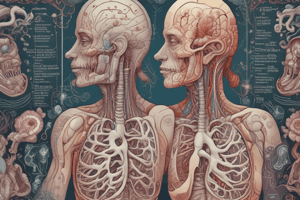Podcast
Questions and Answers
What percentage of diaphragmatic muscle fibers are of the slow twitch fatigue-resistant variety?
What percentage of diaphragmatic muscle fibers are of the slow twitch fatigue-resistant variety?
- 75%
- 65%
- 45%
- 55% (correct)
What is the main role of the diaphragm?
What is the main role of the diaphragm?
- Supporting the mediastinum
- Abdominal straining
- Expiratory
- Inspiratory (correct)
What happens to the mediastinum when the diaphragm contracts during tranquil inspiration?
What happens to the mediastinum when the diaphragm contracts during tranquil inspiration?
- It ascends
- It is disturbed
- It descends
- It remains unchanged (correct)
What is the source of the phrenic nerves that supply the diaphragm?
What is the source of the phrenic nerves that supply the diaphragm?
What is the effect of the diaphragm's contraction on the lung bases during tranquil inspiration?
What is the effect of the diaphragm's contraction on the lung bases during tranquil inspiration?
What is the origin of the septum transversum?
What is the origin of the septum transversum?
What happens to the domes of the diaphragm during tranquil inspiration?
What happens to the domes of the diaphragm during tranquil inspiration?
What type of muscle cells invade the septum transversum?
What type of muscle cells invade the septum transversum?
What is the primary muscle responsible for inspiration?
What is the primary muscle responsible for inspiration?
What occurs during expiration?
What occurs during expiration?
What is the result of the sliding type of hiatus hernia?
What is the result of the sliding type of hiatus hernia?
What is the function of the intercostal muscles during respiration?
What is the function of the intercostal muscles during respiration?
What is the characteristic feature of hiccup?
What is the characteristic feature of hiccup?
What occurs during maximal inspiratory efforts?
What occurs during maximal inspiratory efforts?
What is the effect of the paraoesophageal type of hiatus hernia?
What is the effect of the paraoesophageal type of hiatus hernia?
What assists the relaxation of the diaphragm during expiration?
What assists the relaxation of the diaphragm during expiration?
What is the level to which the central tendon can be depressed by further descent of the domes?
What is the level to which the central tendon can be depressed by further descent of the domes?
What is the most common cause of congenital diaphragmatic hernia?
What is the most common cause of congenital diaphragmatic hernia?
What happens to the vena caval foramen during maximum inspiration?
What happens to the vena caval foramen during maximum inspiration?
Where is the smaller hernial site located?
Where is the smaller hernial site located?
What is the effect of diaphragmatic contraction on intra-abdominal pressure?
What is the effect of diaphragmatic contraction on intra-abdominal pressure?
What is the function of the muscle sling of the right crus?
What is the function of the muscle sling of the right crus?
During maximum inspiration, what happens to the ribs of the costal margin?
During maximum inspiration, what happens to the ribs of the costal margin?
What is the clinical manifestation of Bochdalek's foramen?
What is the clinical manifestation of Bochdalek's foramen?
Study Notes
Diaphragm and Respiratory System
- The diaphragm is the main muscle of inspiration, and it is responsible for sucking down the lung bases and not disturbing the mediastinum.
- During tranquil inspiration, the diaphragm's contraction only descends the domes, and in deeper breaths, further descent of the domes can depress the central tendon from T8 to T9 level.
- Maximum inspiration involves further contraction of the muscle, which everts the ribs of the costal margin in a 'bucket handle'-like movement with widening of the subcostal angle.
- The diaphragm is used also in abdominal straining, and its contraction is accompanied by closure of the glottis and subsequent release of trapped air to produce the characteristic sound of a hiccup.
- Expiration is a passive process, where the diaphragm is relaxed, and its fibres are elongated by pressure from below.
Thoracic Movements and Respiration
- The external intercostals are most active in inspiration, and the internal intercostals are more important for expiration and stiffening of the chest wall.
- Elastic recoil of the lungs assisted by contraction of the muscles of the abdominal wall makes the relaxed diaphragm regain its domed form during expiration.
- Other muscles, such as scalene muscles, sternocleidomastoid, quadratus lumborum, erector spinae, and pectoralis major, contribute to chest expansion during maximal inspiratory efforts.
Development of the Diaphragm
- The diaphragm develops from four sources: septum transversum, third, fourth, and fifth cervical myotomes, pleuroperitoneal membranes, and oesophageal mesentery.
- Failure of pleuroperitoneal membrane development is the most common cause of congenital diaphragmatic hernia.
Diaphragmatic Hernia
- The most common acquired variety of diaphragmatic hernia is the sliding type of hiatus hernia, where the oesophagogastric junction rises up into the thorax, encouraging gastro-oesophageal reflux.
- The paraoesophageal (rolling) type is rarer, where the oesophagogastric junction remains in the abdomen, but a pouch of peritoneum containing a part of the stomach projects upwards alongside the oesophagus, compressing the lower oesophagus and compromising the blood supply of the herniated stomach.
Studying That Suits You
Use AI to generate personalized quizzes and flashcards to suit your learning preferences.
Related Documents
Description
Test your knowledge of the diaphragm's role in the respiratory system, including its muscle contraction and effect on lung bases and mediastinum.



